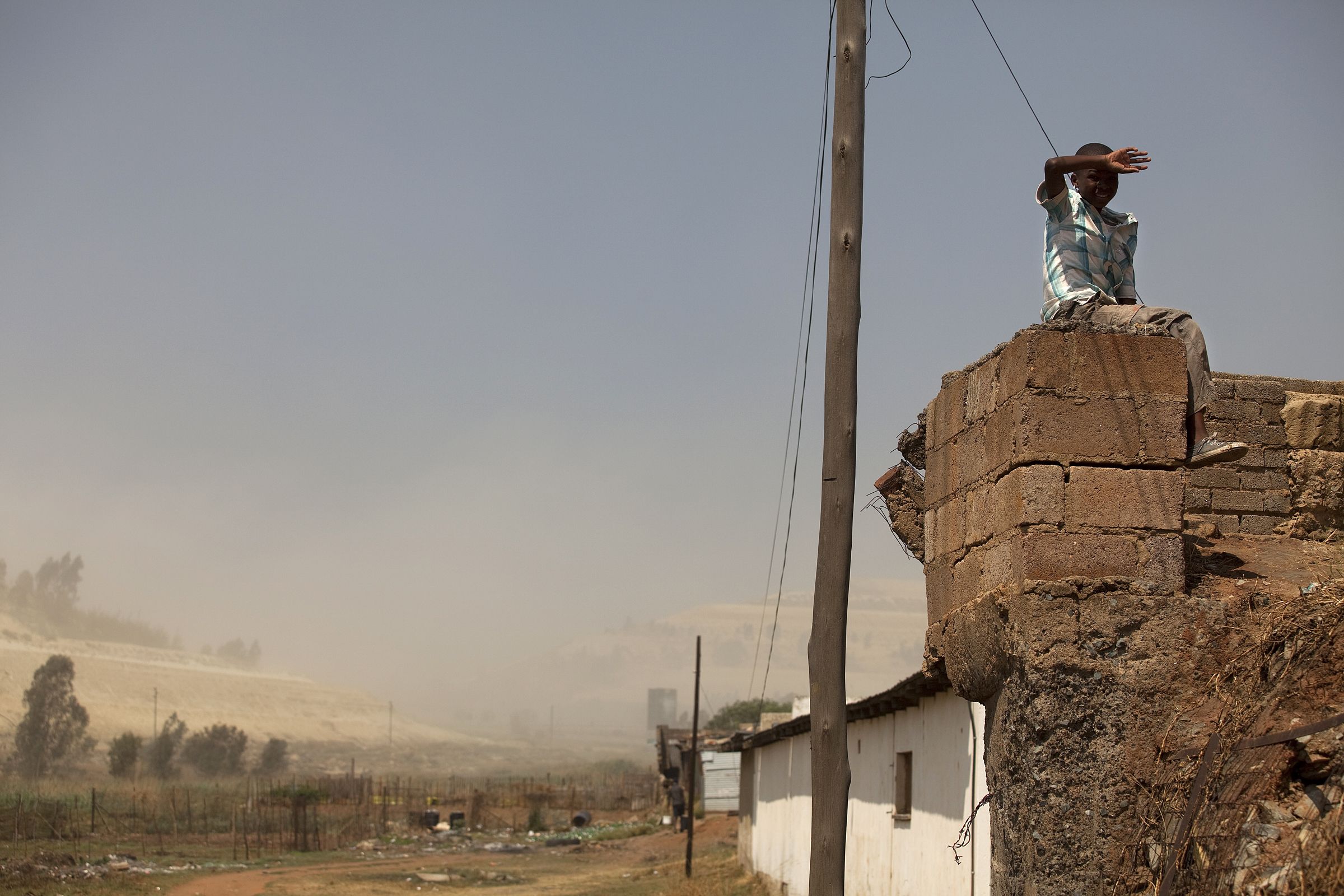On the role of race, geography, and other axes of inequality in the Anthropocene, see Gabrielle Hecht, “The African Anthropocene,” Aeon, February 6, 2018, ➝; Françoise Vergès, “Capitalocene, Waste, Race, and Gender,” e-flux Journal 100, May 2019, ➝; Kathryn Yusoff, “White Utopia/Black Inferno: Life on a Geologic Spike,” e-flux Journal 97, February 2019, ➝; Katherine McKittrick, “Plantation Futures,” Small Axe 17, no. 3 (November 2013): 1–15; Peter James Hudson, “The Racist Dawn of Capitalism,” Boston Review, March 1, 2016; Malcolm Ferdinand, Une écologie décoloniale: Penser l’écologie depuis le monde caribéen (Paris: Le Seuil, 2019); Jeremy Foster, Washed With Sun: Landscape and the Making of White South Africa (Pittsburgh: University of Pittsburgh Press, 2008).
María Jesús Puy-Alquiza et al., “The Mine Tailings as Construction Material in the Viceregal Period: Case Study in Guanajuato City, Mexico,” Boletín de La Sociedad Geológica Mexicana 71, no. 2 (May 2019): 543–64.
U.S. Bureau of Mines and IIT Research Institute, Proceedings of the Symposium: Mineral Waste Utilization, March 27–28, 1968, IIT Research Institute, Chicago, IL.
Murray A. Schwartz, “Foreword,” in U.S. Bureau of Mines and IIT Research Institute, Proceedings of the Second: Mineral Waste Utilization Symposium, March 18–19, 1968, IIT Research Institute, Chicago, IL.
W. Gutt and Philip Nixon, “Use of Waste Materials in the Construction Industry: Analysis of the RILEM Symposium by Correspondence,” Matériaux et Constructions 12, no. 70 (1979): 255–306, 294.
Gabrielle Hecht, Being Nuclear: Africans and the Global Uranium Trade (Johannesburg: Wits University Press, 2012).
Gabrielle Hecht, “Interscalar Vehicles for the African Anthropocene: On Waste, Temporality, and Violence,” Cultural Anthropology 33, no. 1 (2018): 109–141.
See United Nations, “Housing in the Tropics,” and G. Anthony Atkinson, “Design and Construction in the Tropics,” in United Nations Housing and Town and Country Planning Bulletin 6 (New York: United Nations, 1952); Francis Macdonald, Terracrete: Building with Rammed Earth-cement (Research paper, Chestertown, 1939), ➝; Iain Jackson et al., “The Volta River Project: planning, housing and resettlement in Ghana, 1950–1965,” The Journal of Architecture 24, no. 4 (May 2019).
Damilare Ogunsanya, “Muddy, Muddier, Muddiest — Does Urban Architecture in Nigeria need to get dirty?” Medium, June 2, 2020, ➝.
United Nations, “Housing in the Tropics,” 2.
Noted in Ijlal Muzzafar, “The Periphery Within: Modern Architecture and the Making of the Third World” (PhD diss., MIT, 2007); but see also Donna Mehos and Suzanne Moon, “The Uses of Portability: Circulating Experts in the Technopolitics of Cold War and Decolonization,” in Entangled Geographies: Empire and Technopolitics in the Global Cold War, ed. Gabrielle Hecht (Cambridge: MIT Press, 2011).
United Nations, “UNKRA's Help to Korea: Housing,” UN News & Media, ➝.
Muzzafar, “The Periphery Within.”
Ibid., 23–24.
Centro Interamericano de Vivienda y Planeamiento, “El CINVA-RAM, maquina portatil para fabricar bloques de tierra estabilizada,” Ekistics 5, no. 28 (January 1958): 18–20; Peter Gallant, Self-Help Construction of 1-Story Buildings 6 (Washington, D.C.: Peace Corps, 1977), ➝.
Labelle Prussin, “Non-Western Sacred Sites: African Models,” Journal of the Society of Architectural Historians 58, no. 3 (1999): 424–433, ➝.
Dynamics like these proliferated across the postcolonial world. For example, Daniel Williford argues that concrete combined with new types of finance to shape housing and urban crisis in colonial and postcolonial Morocco. Daniel Williford, “Concrete Futures: Technologies of Urban Crisis in Colonial and Postcolonial Morocco” (PhD diss., University of Michigan, 2020).
Hannah le Roux, “Circulating Asbestos,” It’s Simple: Histories of Architecture and/for the Environment, October 19, 2018, Columbia University, New York). These sheetings performed similarly in the warm, humid tropics. Otto Koenigsberger and Robert Lynn, Roofs in the Warm Humid Tropics (London: Lund Humphries, 1965).
Stephan Miescher, “Building the City of the Future: Visions and Experiences of Modernity in Ghana’s Akosombo Township,” The Journal of African History 53, no. 3 (November 2012): 367–90.
Alan Berger, Drosscape: Wasting Land in Urban America (New York: Princeton Architectural Press, 2007).
Simon Gawu, Emmanuel Amissah, and J.S.Y. Kuma, “The proposed alumina industry and how to mitigate against the red mud footprint in Ghana,” Journal of Urban and Environmental Engineering 6, no. 2 (2012): 48–56, ➝.
Nancy J. Jacobs, Environment, Power and Injustice: A South African History (Cambridge: Cambridge University Press, 2003).
Robert R. Jones, Assessment of environmental contamination from asbestos: Findings for the former asbestos mining regions of South Africa (Grahamstown: Department of Environmental Affairs and Tourism, 2006).
See, for instance, conditions at Kuruman mines in the 1950s in “Blue asbestos mines at Kuruman, Westerberg and Koegas,” (South Africa: Periscope Film, 1950s), ➝; Jock McCulloch, Asbestos blues: labour, capital, physicians & the state in South Africa (Bloomington: Indiana University Press, 2002).
Emily Apter, "Overburden," e-flux architecture (2017), ➝.
C.E. Fivaz, “How the MacArthur-Forrest cyanidation process ensured South Africa’s golden future,” Journal of South African Institute of Mining and Metallurgy 88, no. 9 (1988).
Frank Winde, Uranium Pollution of Water: A Global Perspective on the Situation in South Africa (Vanderbijlpark: North-West University, 2013).
For additional details and references, see Gabrielle Hecht, “Residue,” Somatosphere, Winter 2018, ➝.
See Siân Butcher, “Making and Governing Unstable Territory: Corporate, State and Public Encounters in Johannesburg’s Mining Land, 1909–2013,” The Journal of Development Studies 54, no. 12 (December 2018): 2186–2209, ➝; Kerry Bobbins and Guy Trangos, Mining landscapes of the Gauteng City-Region (Johannesburg: Gauteng City-Region Observatory, 2018); Wim Wambecq et al., “From mine to life cycle closure: towards a vision for the West Rand, Johannesburg,” October 1–3, 2014, Mine Closure 2014, Johannesburg.
“Fleurhof,” Calgro, 2016, ➝.
South African building regulations do not apply to dwellings below 80 square meters in size. See SABS, “The Application of the National Building Regulations, Part A: General principles and requirements,” in SANS 10400-A: 2016, ed. South African Bureau of Standards (Pretoria: SABS Standards Division, 2016).
For more on zama-zamas, see Rosalind Morris, “Death and the Miner,” Berlin Journal 23: 6–11, ➝.
The authors thank Jonathan Melamdowitz and Kevin Chen, who provided valuable research assistance for this essay.
